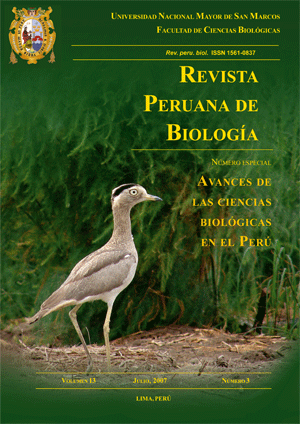Diversity and state of conservation of Amazonian waterbodies in the Northeast of Peru
DOI:
https://doi.org/10.15381/rpb.v13i3.2336Keywords:
Fishfauna, aquatic biota, Biodiversity, Peruvian Amazon, conservationAbstract
The present paper describes the diversity and state of conservation, determinate by a rapid biological inventory, carried out since October 24 to 30 of 2005, at the Amazonian waterbodies from Northeast of Peru, between 680 and 133 m of altitude, among Tarapoto (San Martin) and Yurimaguas (Loreto). Data and samples were collected in 26 stations. Planckton samples were collected with standard net (40 microns), benthos with Surber net and fishes with small mesh seines. Descriptions of each habitat included coordinates (UTM), and limnological characteristics (pH, temperature, conductivity, oxygen). The richness of species of fishes was of 95, dominated by Characiformes and Siluriformes. Richness of species in phytoplankton was of 74, in zooplankton, 22 species and in benthos of 20 species. The conservation state was determined using the Index of Biological Integrity (IBI) for fishes, and EPT index (Ephemeroptera, Plecoptera, and Trichoptera) for the aquatic environments. The results indicate that in the better zones conserved were found in the around of Yurimaguas.Downloads
Downloads
Published
Issue
Section
License
Copyright (c) 2006 Hernán Ortega, Blanca Rengifo, Iris Samanez, Carlos Palma

This work is licensed under a Creative Commons Attribution-NonCommercial-ShareAlike 4.0 International License.
AUTHORS RETAIN THEIR RIGHTS:
a. Authors retain their trade mark rights and patent, and also on any process or procedure described in the article.
b. Authors retain their right to share, copy, distribute, perform and publicly communicate their article (eg, to place their article in an institutional repository or publish it in a book), with an acknowledgment of its initial publication in the Revista Peruana de Biologia.
c. Authors retain theirs right to make a subsequent publication of their work, to use the article or any part thereof (eg a compilation of his papers, lecture notes, thesis, or a book), always indicating its initial publication in the Revista Peruana de Biologia (the originator of the work, journal, volume, number and date).






